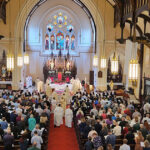By Corinne Winter
On July 22, the church celebrated the feast of St. Mary Magdalene. Just a year ago, Pope Francis raised what had been a memorial of the saint to a feast, calling the church to pay greater attention to her as a model or sign of the meaning of Christian life. The pope called Mary of Magdala “a true and authentic Evangelizer,” echoing such notable theologians as Augustine, Bernard of Clairvoux and Thomas Aquinas, as well as the Eastern Catholic Tradition who hold up Mary Magdalene as “Apostle to the Apostles.” Pope Leo I said she was a “figure of the church,” and Pope Gregory the Great said she announced life to humanity. The title of apostle reflects the account in the Gospel of John in which Jesus exhorts Mary to go tell his brothers that he is risen. Mary runs to do so, announcing that she has “seen the Lord.”

As is true of many key biblical figures, we have very little information about Mary’s life. Still, she appears in a number of Gospel stories that provide important insights into the Christian vocation. Let’s look at four aspects: vocation, works of mercy, fidelity and witness to the resurrection.
Biblical scholars debate a precise statement of Mary’s status among Jesus’ other disciples. There is no account of her calling that parallels those of Peter, James and John, for example; but she is certainly depicted as having experienced and responded to a call from Jesus. That is clear in the resurrection account mentioned above. And she appears as a follower of Jesus much earlier, at least in the Gospel of Luke where she is named as one of the women who, having been healed by Jesus, traveled with him and the other disciples, “assisting them out of their means (Lk 8:3).”
Pope Francis would certainly have been drawn to the figure of Mary as well as the other women as exemplars of the works of mercy he consistently admonishes us to practice as a form of spreading the Good News. Surely the women’s ministry among the disciples would have included feeding the hungry and giving drink to the thirsty. The Synoptic Gospels, more clearly than the Gospel of John, also attribute Magdalene’s journey to the tomb on Easter morning to a desire to assure that Jesus had been honored with proper burial rites — to “bury the dead.”
In the passion and resurrection accounts, Mary can be seen as a sign of faithful discipleship. In the fourth Gospel, Mary is one of three (all named Mary) who are described as being present at the foot of the cross while others have vanished. St. Augustine called attention to the contrast saying that while most of the male disciples had fled in fear, these three women, moved by love and compassion that overcame fear, remained. Furthermore, whether to anoint the body, or simply to be present at the tomb, all four Gospels say that very early (as soon as it would have been permissible under Jewish Sabbath law), Mary of Magdala — with other women or alone — sets out to find Jesus once again. In the Gospel of John, she is shown demanding of the “gardener” that he tell her where Jesus is so that they can find him and bring him back.
The quest to find, to honor or simply to mourn Jesus brings Mary to the point of being among the first witnesses to the resurrection. According to all four Gospels, Mary sees the empty tomb of Jesus. The Gospels of Matthew and Mark have Mary and other women being told by angels to tell the others that Jesus is risen. In the Gospel of John, Mary is alone when Jesus himself commissions her to spread the news to the other disciples. In the Gospel of Luke, the women are said to have been told to recall the words of Jesus and to understand that he is risen. They are not ordered to tell the others, but they do. The various Gospel accounts portray diverse responses to the women’s testimony, but all agree that they spread the Good News.
The canonical Gospels include no further mention of Mary Magdalene. For several centuries, a tendency in the church was to conflate her with other women such as the one caught in adultery or the one who washed Jesus’ feet with her hair. That error led to the now rejected image of Mary Magdalene as a forgiven prostitute. But the few passages we have make her, according to the Tradition of the Church, a sign of our calling as Christians. To be Christian means to respond to the call of Jesus, to engage in works of mercy, to be faithful even (or perhaps especially) in difficult times, and to bear witness to the resurrection.
(Corinne Winter is a professor-emeritus of St. Ambrose University, Davenport.)











